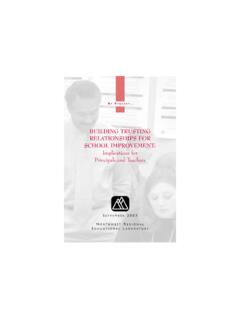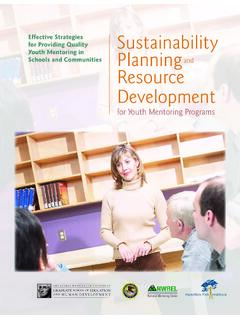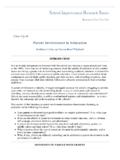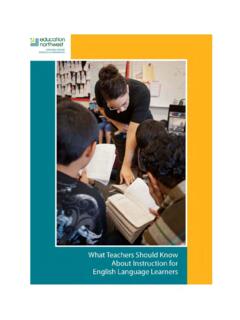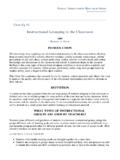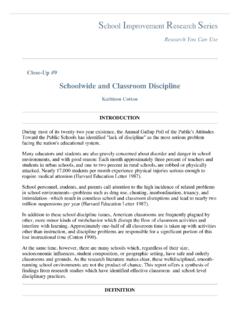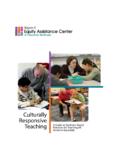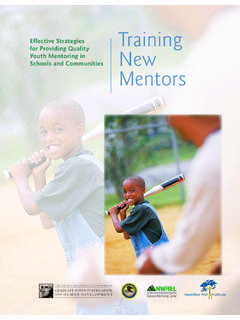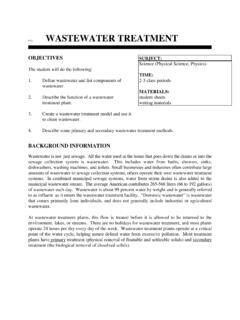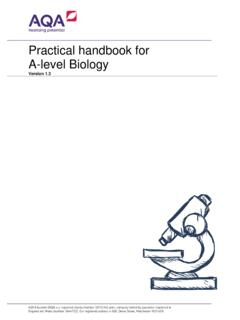Transcription of THE MULTIGRADE CLASSROOM - Education Northwest
1 THE MULTIGRADE CLASSROOM : A RESOURCE handbook FOR SMALL, RURAL SCHOOLS. Book 1: Review of the Research on MULTIGRADE Instruction November 1999. Rural Education Program Based on the September 1989 publication of the same title written by Bruce A. Miller Susan Vincent, Editor Joyce Ley, Director Northwest Regional Educational Laboratory 101 Main Street, Suite 500. Portland, Oregon 97204. Acknowledgments The following selections have been reprinted with permission: Cohen, E. (1986). Designing groupwork: Strategies for the heterogeneous class- room (pp. 207 209). New York, NY: Teachers College Press. (Reprinted with permission of publisher.). Emmer, (1987). CLASSROOM management and discipline. In V. Richardson-Koehler & Berliner (Eds.), Educators' handbook : A research perspective (pp.)
2 233-258). White Plains, NY: Longman. (Reprinted with permission of publisher.). Evertson, , Emmer, , Clements, , Sanford, , & Williams, E. (1981). Organizing and managing the elementary school CLASSROOM . Austin, TX: University of Texas, Research and Development Center for teacher Education . (Reprinted with permission of Carolyn Evertson, Peabody College, Vanderbilt University, Nashville, TN.). Gaustad, J. (1994). Nongraded Education : Overcoming obstacles to imple- menting the MULTIGRADE CLASSROOM [Special issue]. OSSC Bulletin, 38(3. & 4). (Reprinted with permission of author.). Gibbons, M., & Phillips, G. (1978). Helping students through the self- Education crisis. Phi Delta Kappan, 60(4), 296 300. (Reprinted with permission of publisher.). Kagan, S. (1989). Cooperative learning: Resources for teachers.
3 San Juan Capistrano, CA: Resources for Teachers. (Reprinted with permission of publisher.). Karweit, N. (1987). Diversity, equity, and CLASSROOM processes. In Hallinan (Ed.), Social organization of schools: New conceptualizations of the learning process (pp. 71 102). New York, NY: Plenum Press. (Reprinted with permission of publisher.). Kentucky Department of Education . (1996). Nearly all Kentucky schools show improvement in latest KIRIS scores, but middle schools lag behind [Press release]. Frankfort, KY: Author. (Reprinted with permission of author.). Murphy, J., Weil, M., & McGreal, T. (1986). The basic practice model of instruction. Elementary School Journal, 87(1), 83 96. (Reprinted with permission of the University of Chicago Press.). Oregon Department of Education , & Ackerman Laboratory School.
4 (1994). Mixed-age programs, 1993 94. Salem, OR: Oregon Department of Education . (Reprinted with permission of publisher.). Pavan, (1992). The benefits of nongraded schools. Educational Leadership, 50(2), 22 25. (Reprinted with permission of author.). ii The MULTIGRADE CLASSROOM Slavin, (1987). Ability grouping and student achievement in elemen- tary schools: A best-evidence synthesis. Review of Educational Research, 57(3), 293 336. (Reprinted with permission of the American Educational Research Association.). Slavin, (1988). Synthesis of research on grouping in elementary and secondary schools. Educational Leadership, 46(1), 67 77. (Reprinted with permission of the Association for Supervision and Curriculum Development.). Slavin, , & Madden, (1989). What works for students at risk: A research synthesis.
5 Educational Leadership, 46(5), 4 13. (Reprinted with permission of the Association for Supervision and Curriculum Development.). Thomas, , Strage, A., & Curley, R. (1988). Improving students' self- directed learning: Issues and guidelines. Elementary School Journal, 88(3), 313 326. (Reprinted with permission of the University of Chicago.). iii Overview Preface The preface describes the process used in developing this handbook , including the MULTIGRADE teachers who shared their CLASSROOM strategies and ideas for improving the usefulness of the handbook . Introduction The history of MULTIGRADE CLASSROOM instruction is presented, along with the background information that describes why MULTIGRADE instruction is an important and complex issue for educators. Book 1: Review of the Research on MULTIGRADE Instruction In this book, the research on MULTIGRADE instruction is reviewed in order to answer two questions: (1) What effect does MULTIGRADE instruction have on student performance?
6 And (2) What kind of train- ing is needed in order to teach in a MULTIGRADE CLASSROOM ? Detailed information focusing on organizing and teaching in a MULTIGRADE class- room is also presented. Book 2: CLASSROOM Organization This book describes strategies for arranging and organizing instruc- tional resources and the physical environment of the CLASSROOM . Sample CLASSROOM layouts and a design kit for organizing your CLASSROOM are also included. Book 3: CLASSROOM Management and Discipline Establishing clear expectations for student behavior and predictable CLASSROOM routines has been shown to improve student performance. In this book, research relating to CLASSROOM management and discipline are presented, along with a checklist for planning management routines and discipline procedures.
7 Book 4: Instructional Organization, Curriculum, and Evaluation Research-based guidelines for planning, developing, and implementing instructional strategies are presented. This book emphasizes the devel- opment of cooperative work norms in the MULTIGRADE CLASSROOM and explains how to match instruction to the needs of students. An overview of curriculum and evaluation planning concepts is also provided. This book is a close companion piece with book 5: Instructional Delivery and Grouping. iv The MULTIGRADE CLASSROOM Book 5: Instructional Delivery and Grouping This book emphasizes that instructional quality and student grouping are key components for success in the MULTIGRADE CLASSROOM . Instructional methods such as recitation, discussion, and cooperative learning are reviewed. Planning guides and examples are also included where appropriate.
8 Strategies for organizing group learning activities across and within grade levels, especially those that develop interde- pendence and cooperation among students, are discussed. Book 6: Self-Directed Learning Developing skills and strategies in students that allow for a high level of independence and efficiency in learning, either individually or in combination with other students, is essential in the MULTIGRADE class- room. Ideas for developing self-direction are presented in this book. Book 7: Planning and Using Peer Tutoring This book provides guidelines for developing skills and routines whereby students serve as teachers to other students within and across differ- ing grade levels. The research on what makes for effective tutoring in the CLASSROOM is also reviewed. v Preface he development of this handbook began in 1987, when a group T of people involved in rural Education raised several issues regarding MULTIGRADE CLASSROOM instruction.
9 In their discussions, members of the advisory committee for the Northwest Regional Educational Laboratory's (NWREL) Rural Education Program agreed that MULTIGRADE teacher training in their respective states was either lacking or wholly inadequate. They also were concerned about the availability of research and training materials to help rural MULTIGRADE teachers improve their skills. As a result of these concerns, the Rural Education Program decided to develop a handbook to assist the MULTIGRADE teacher . The handbook evolved in several stages. The first was a comprehensive review, conducted by Dr. Bruce Miller, of the research on MULTIGRADE instruction that included articles, books, and research reports from the United States, Canada, Australia, and other countries. From this review, six topic areas emerged that are considered essential for effective MULTIGRADE instruction: CLASSROOM organization; CLASSROOM manage- ment and discipline; instructional organization, curriculum, and evaluation.
10 Instructional delivery and grouping; self-directed learning; and planning and using peer tutoring. Dr. Miller developed the handbook around these six instructional areas, and a draft was completed in June 1989, with support from the Office of Educational Research and Improvement (OERI). The second stage occurred in July 1989, when a conference was held in Ashland, Oregon, with MULTIGRADE teachers who were recommended by educa- tional leaders from throughout the Northwest and Pacific Island regions. During the conference, participants were organized into workgroups, each focusing on one of the topic areas. Their tasks were to review the appropriate handbook chapter for clarity and content, to suggest alternative and/or additional instructional strategies to those presented in the handbook , and to write case descriptions of activities drawn from their classrooms.
